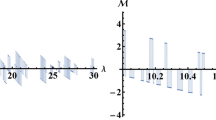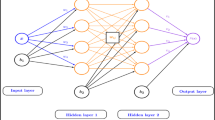Abstract
This paper presents a new numerical tool to model the two-dimensional contaminant transport through saturated porous media using a meshfree method, called radial point interpolation method (RPIM) with polynomial reproduction. In RPIM, an approximate solution is constructed entirely in terms of a set of nodes and no characterisation of the interrelationship of the nodes is needed. The advection–dispersion equation with sorption is considered to illustrate the applicability of the RPIM. The Galerkin weak form of the governing equation is formulated using 2D meshfree shape functions constructed using thin plate spline radial basis functions. MATLAB code is developed to obtain the numerical solution. Three numerical examples are presented and the results are compared with those obtained from the finite element method and analytical solutions. In order to test the practical applicability and performance of the RPIM, two case studies of contaminant transport through landfill liners are presented. A good agreement is obtained between the results of the RPIM and the field investigation data.















Similar content being viewed by others
Abbreviations
- a i :
-
Coefficient for radial basis function
- b j :
-
Coefficient for monomial basis function
- C :
-
Contaminant concentration
- C 0 :
-
Concentration of contaminant at the source
- C i :
-
Initial concentration of contaminant
- D :
-
Coefficient of hydrodynamic dispersion
- g :
-
Concentration gradient at the exist boundary
- K d :
-
Distribution coefficient
- M :
-
Number of polynomial terms
- N :
-
Number of nodes
- θ :
-
Porosity of contaminant soil
- n s :
-
Unit normal to domain
- p j :
-
Basis function of monomial
- P Q :
-
Moment matrix of monomial basis function
- q :
-
Thin plate spline radial basis function shape parameter
- Q :
-
Nodal mass flux
- R :
-
Retardation coefficient
- R i :
-
Thin plate spline radial basis function
- r i :
-
Radial distance between x and x i
- R Q :
-
Moment matrix of radial basis function
- t :
-
Time
- u :
-
Discharge velocity
- v :
-
Seepage velocity
- x :
-
Spatial coordinate
- Ω:
-
Problem domain
- \( \Upphi \) :
-
Meshfree shape function
- ρ d :
-
Bulk density of contaminant soil
- Γ :
-
Surface boundary of domain
- ε:
-
Constant
References
Atluri SN, Zhu T (1998) A new meshless local Petrov–Galerkin (MLPG) approach in computational mechanics. Comput Mech 22:117–127
Bear J (1979) Hydraulics of groundwater. McGraw-Hill, New York
Beuth L, Benz T, Vermeer PA, Coetzee CJ, Bonnier P, Van Den Berg P (2007) Formulation and validation of a quasi-static material point method. In: Proceedings of the 10th international symposium on numerical methods in Geomechanics (NUMOG), Rhodes, Greece, pp 189–195
Boztosun I, Charafi A (2002) An analysis of the linear advection-diffusion equation using mesh-free and mesh-dependent methods. Eng Anal Bound Elem 26:889–895
Boztosun I, Charafi A, Zerroukat M, Djidjeli K (2002) Thin-plate spline radial basis function scheme for advection–diffusion problems. Electron J Bound Elem BETEQ 2001:267–282
Boztosun I, Charafi A, Boztosun D (2003) On the numerical solution of linear advection-diffusion equation using compactly supported radial basis functions, vol 26. In: Griebel M, Alexander Schweitzer M (eds) Lecture notes in Comput Sci Eng Meshfree Methods for Partial Diff Eq. Springer, pp 63–73
Chinchapatnam PP, Djidjeli K, Nair PB (2006) Unsymmetric and symmetric meshless schemes for the unsteady convection-diffusion equation. Comp Meth Appl Mech Eng 195:2432–2453
Coetzee CJ (2004) The modelling of granular flow using the particle-in-cell method. PhD Thesis, University of Stellenbosch, South Africa
Coetzee CJ, Vermeer PA, Basson AH (2005) The modelling of anchors using the material point method. Int J Numer Anal Methods Geomech 29:879–895
Craig JR, Rabideau AJ (2006) Finite difference modelling of contaminant transport using analytic element flow solutions. Adv Water Resour 29:1075–1087
Crank J (1956) The mathematics of diffusion. Oxford Press, London
Dolbow J, Belytschko T (1998) An introduction to programming the meshless element-free Galerkin method. Arch Comput Methods Eng 5:207–241
Domenico P (1987) An analytical model for multidimensional transport of a decaying contaminant species. J Hydrol 91:49–58
Durner W, Schultze B, Zurmühl T (1999) State-of-the-art in inverse modeling of inflow/outflow experiments. In: van Genuchten MTh, Leij FJ, Wu L (eds) Proceedings of international workshop on characterisation and measurement of the hydraulic properties of unsaturated porous media, University of California, Riverside, CA, pp 661–681
Eldho TI, Rao BV (1997) Simulation of two-dimensional contaminant transport with dual reciprocity boundary elements. Eng Anal Bound Elem 20:213–228
Finsterle S (2004) Multiphase inverse modelling: review and iTOUGH2 applications. Vadose Zone J 3:747–762
Freiboth S, Class H, Helmig R (2007) Numerical simulation of multiphase multicomponent processes considering structural alterations of porous media—a phenomenological model. In: Schanz T (ed) Theoretical and numerical unsaturated soil mechanics. Springer, Berlin, pp 127–134
Freiboth S, Class H, Helmig R, Graf T, Ehlers W, Schwarz V, Vrettos C (2009) A model for multi-phase flow and transport in porous media including a phenomenological approach to account for deformation—a model concept and its validation within a code intercomparison study. Comput Geosci 13:281–300
Frind EO (1988) Solution of the advection–dispersion equation with free exit boundary. Numer Methods Partial Differ Equ 4:301–313
GeoSlope International Ltd (2007) Transport modelling with CTRAN/W 2007: an engineering methodology, student version 7.02, Alberta, Canada
Golberg MA, Chen CS, Bowman H (1999) Some recent results and proposals for the use of radial basis functions in the BEM. Eng Anal Bound Elem 23:285–296
King KS, Quigley RM, Fernandez F, Reades DW, Bacopoulos A (1993) Hydraulic conductivity and diffusion monitoring of the Keele Valley Landfill liner, Maple, Ontario. Can Geotech J 30:124–134
Li J, Chen Y, Pepper D (2003) Radial basis function method for 1-d and 2-d groundwater contaminant transport modelling. Comput Mech 32:10–15
Liu WK, Jun S, Zhang YF (1995) Reproducing kernel particle methods. Int J Numer Methods Eng 20:1081–1106
Liu GR, Zhang GY, Gu YT, Wang YY (2005) A meshfree radial point interpolation method (RPIM) for three-dimensional solids. Comput Mech 36:421–430
Monaghan JJ (1992) Smoothed particle hydrodynamics. Annu Rev Astron Astrophys 30:543–574
Ogata A, Banks RB (1961) A solution of the differential equation of longitudinal dispersion in porous media. USGS, Professional paper: 411-A, Reston, VA
Praveen Kumar R (2008) Modelling of 1d, 2d and 3d contaminant transport through saturated and unsaturated porous media using meshfree techniques. PhD Thesis, Indian Institute of Technology Madras, India
Praveen Kumar R, Dodagoudar GR (2008) Two-dimensional modelling of contaminant transport through saturated porous media using the radial point interpolation method (RPIM). Hydrogeol J 16:1497–1505
Praveen Kumar R, Dodagoudar GR, Rao BN (2007) Meshfree modelling of one-dimensional contaminant transport in unsaturated porous media. Geomech Geoeng An Int J 2:129–136
Priesack E, Durner W (2006) Closed-form expression for the multi-modal unsaturated conductivity function. Vadose Zone J 5:121–124
Quigley RM, Rowe RK (1986) Leachate migration through clay below a domestic waste landfill, Sarnia, Ontario, Canada: chemical interpretation and modelling philosophies. In: Lorenzen D, Conway RA, Jackson LP, Hamza A, Perket CL, Lacy WJ (eds) Hazardous and industrial solid waste testing and disposal, vol 6, ASTM STP 933. American Society for Testing and Materials, Philadelphia, pp 93–103
Quigley RM, Fernandez F, Yanful E, Helgason T, Margaritis A, Whitby JL (1987) Hydraulic conductivity of contaminated natural clay directly beneath a domestic landfill. Can Geotech J 24:377–383
Rowe RK, Booker JR (1985) 1-D pollutant migration in soils of finite depth. J Geotech Eng ASCE 111:479–499
Rowe RK, Quigley RM, Brachman RWI, Booker JR (2004) Barrier systems for waste disposal. E & FN Spon Press, London
Sheu WHT, Chen YH (2002) Finite element analysis of contaminant transport in groundwater. Appl Math Comput 127:23–43
Sukumar N, Moran B, Semenov AY, Belikov VV (2001) Natural neighbour Galerkin methods. Int J Numer Methods Eng 50:1–27
Sulsky D, Chen Z, Schreyer HL (1994) A particle method for history-dependent materials. Comput Methods Appl Mech Eng 118:179–196
van Genuchten MTh (1981) Analytical solutions for chemical transport with simultaneous adsorption, zero-order production and first-order decay. J Hydrol 49:213–233
Vermeer PA, Beuth L, Benz T (2008) A quasi-static method for large deformation problems in geomechanics. In: Proceedings of the 12th international conference of international association for computer methods and advances in geomechanics (IACMAG), Goa, India, pp 55–63
Wang JG, Liu GR (2002) A point interpolation meshless method based on radial basis functions. Int J Numer Methods Eng 54:1623–1648
Zimmermann S, Koumoutsakos P, Kinzelbach W (2001) Simulation of pollutant transport using a particle method. J Comput Physics 173:322–347
Author information
Authors and Affiliations
Corresponding author
Rights and permissions
About this article
Cite this article
Praveen Kumar, R., Dodagoudar, G.R. Two-dimensional meshfree modelling of contaminant transport through saturated porous media using RPIM. Environ Earth Sci 61, 341–353 (2010). https://doi.org/10.1007/s12665-009-0346-4
Received:
Accepted:
Published:
Issue Date:
DOI: https://doi.org/10.1007/s12665-009-0346-4




